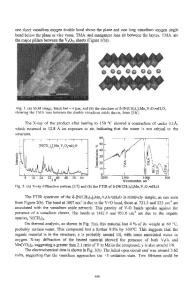Facile and Scalable Synthesis of Copolymer-Sulfur Composites as Cathodes for High Performance Lithium-Sulfur Batteries
- PDF / 724,968 Bytes
- 6 Pages / 612 x 792 pts (letter) Page_size
- 103 Downloads / 462 Views
Facile and Scalable Synthesis of Copolymer-Sulfur Composites as Cathodes for High Performance Lithium-Sulfur Batteries Jingjing Liu1, Brennan Campbell1, Rachel Ye2, Jeffrey Bell1, Zafer Mutlu1, Changling Li1, Yiran Yan1, Mihri Ozkan1,3,*, and Cengiz Ozkan1,2,* 1
Materials Science and Engineering Program, University of California, Riverside, CA, 92521, USA Mechanical Engineering Department, University of California, Riverside, CA, 92521, USA 3 Electrical and Computer Engineering Department, University of California, Riverside, CA, 92521, USA 2
ABSTRACT To promote the energy density of lithium-ion battery, the sulfur-based cathode has attracted extensive attention because of its high specific capacity of 1672 mAh g-1 and its high abundance. However, the sulfur shuttling effects and the loss of active material during lithiation hinder its commercial application. To tackle these issues, we synthesized a stable copolymer-sulfur composite by chemically binding sulfur. The composite with 86% sulfur content was prepared using 1,3-diethynylbenzen and sulfur particles via scalable invers vulcanization. The sulfur content in copolymer sulfur was achieved as high as 86%. Our copolymer-sulfur composite cathode showed excellent cycling performance with a specific capacity of 454 mAh g-1 at 0.1 C after 300 cycles. We demonstrate that the organosulfur-DEB units in the copolymer-sulfur composite serve as the ‘plasticizer’ to effectively prevent the polysulfide shuttling. INTRODUCTION Energy storage plays a most significant role for the industries of consumer electronics, electric vehicles, aerospace applications, and stationary energy storage [1, 2]. Lithium-ion batteries (LIBs) have been the key technology of the rechargeable batteries, considering their high energy-density, low operation voltage, and low rate of self-discharge. However, the capacity of LIBs is still limited. Many efforts have been focused on improving the capacities of LIBs, such as novel anode materials [3-7] and high capacity cathodes [8]. Sulfur is one of the promising cathode materials, because of its high specific capacity, which is 5 times more than that of LiCoO2. However, there are several challenges impeding its commercialization: a). volume expansion (80%) during charge/discharge process; b). low conductivity of Li2S (10-15 cm2 s-1) [9]; c) polysulfide shuttling. In particular, to suppress the polysulfide shuttling, it has been proposed to use carbon-sulfur composite cathode [10, 11], graphene encapsulation sulfur cathodes [12-14] and polymer coated sulfur cathodes [15, 16]. Apart from the stability, scalability of sulfur cathodes is required for commercialization as well. It has been reported that large scale synthesis of copolymer sulfur cathodes can be achieved by inverse vulcanization [1719]. In detail, 1,3-diiso- propenylbenzene was applied to quench diradicals of sulfur chains and to obtain poly(sulfur-random-DIB). Moreover, 1,4-diphenylbutadiyne [20] and 1,4 dicyanobenzene [21] were also used as precursor to synthesize the copolymer-sulfur catho
Data Loading...











